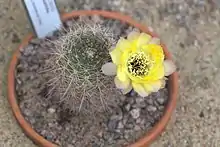| Echinopsis chrysantha | |
|---|---|
 | |
| Scientific classification | |
| Kingdom: | Plantae |
| Clade: | Tracheophytes |
| Clade: | Angiosperms |
| Clade: | Eudicots |
| Order: | Caryophyllales |
| Family: | Cactaceae |
| Subfamily: | Cactoideae |
| Genus: | Echinopsis |
| Species: | E. chrysantha |
| Binomial name | |
| Echinopsis chrysantha Werderm. | |
| Synonyms | |
| |
Echinopsis chrysantha, is a species of Echinopsis found in Argentina.[2]
Description
Echinopsis chrysantha grows solitary. The depressed spherical to short cylindrical, dull grey-green shoots have a diameter of 6 to 7 centimeters and a growth height of 4 to 6 centimeters. The shoots form an enlarged, carrot-like taproot. There are eight to twelve (rarely up to 26) straight or slightly oblique ribs that are slightly bumpy. The areoles on it are about 1.5 centimeters apart. Reddish-brown spines emerge from them, which turn gray with age. Central spines are not formed. The five to seven (rarely from three) laterally radiating radial spines have a length of up to 2 centimeters.
The broad, funnel-shaped flowers appear laterally on the shoots and open during the day. They are yellow to orange with a darker reddish purple throat. The flowers are up to 5 centimeters long.[3]
Distribution
Echinopsis chrysantha is widespread in the Argentine province of Salta in the Quebrada del Toro at altitudes of 2000 to 3000 meters.
Taxonomy
The first description by Erich Werdermann was published in 1931.[4] The specific epithet chrysantha comes from Greek and means 'with (golden) yellow flowers'. Nomenclature synonyms are Lobivia chrysantha (Werderm.) Backeb. (1935) and Hymenorebutia chrysantha (Werderm.) F.Ritter (1980).
References
- ↑ "The IUCN Red List of Threatened Species". IUCN Red List of Threatened Species. 2010-09-20. Retrieved 2023-10-06.
- ↑ "Echinopsis chrysantha". Tropicos. Retrieved 2019-08-22.
- ↑ Anderson, Edward F.; Eggli, Urs (2005). Das grosse Kakteen-Lexikon (in German). Stuttgart (Hohenheim): Ulmer. p. 224-225. ISBN 3-8001-4573-1.
- ↑ Werdermann, E. (1931-11-10). "Neue Kakteen im Botanischen Garten Berlin-Dahlem". Notizblatt des Königl. botanischen Gartens und Museums zu Berlin. JSTOR. 11 (104): 262. doi:10.2307/3994744. ISSN 0258-1485.
External links
 Media related to Echinopsis chrysantha at Wikimedia Commons
Media related to Echinopsis chrysantha at Wikimedia Commons Data related to Echinopsis chrysantha at Wikispecies
Data related to Echinopsis chrysantha at Wikispecies
